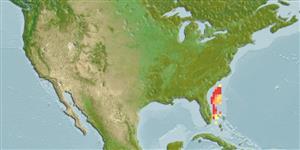इलाज़मौबरांकी (शारक और रेज़) (sharks and rays) >
Rajiformes (Skates and rays) >
Rajidae (Skates)
Etymology: Breviraja: Latin, brevis = short, brief + Latin raja = ray (Raja sp.) (Ref. 45335).
Environment: milieu / climate zone / depth range / distribution range
पारिस्थितिकी
समुद्री बाथीड़िमरसल; गहराई सीमा 293 - 896 m (Ref. 31371). Deep-water; 33°N - 25°N, 81°W - 78°W (Ref. 114953)
Western Central Atlantic: South Carolina to Florida in the USA.
आकार / वज़न / Age
Maturity: Lm ? range ? - ? cm
Max length : 29.4 cm TL पुल्लिंग / अलिंग; (Ref. 31371)
Oviparous (Ref. 50449). Eggs have horn-like projections on the shell (Ref. 205).
Life cycle and mating behavior
परिपक्व अवधि | पुनरुत्पत्ति | मछलीऔ का अंडे देना | अंडे | Fecundity | लार्वा
Oviparous, paired eggs are laid. Embryos feed solely on yolk (Ref. 50449). Eggs have horn-like projections on the shell (Ref. 205).
Last, P.R., S. Weigmann and L. Yang, 2016. Changes to the nomenclature of the skates (Chondrichthyes: Rajiformes). In: Last and Yearsley (eds.). Rays of the World: Supplementary Information. CSIRO Special Publication. 11-34. (Ref. 118749)
IUCN Red List Status (Ref. 130435: Version 2024-1)
Threat to humans
Harmless
Human uses
साधन
Special reports
Download XML
इंटरनेट स्रोत
Estimates based on models
Preferred temperature (Ref.
123201): 7.8 - 15.4, mean 11.5 °C (based on 31 cells).
Phylogenetic diversity index (Ref.
82804): PD
50 = 0.5156 [Uniqueness, from 0.5 = low to 2.0 = high].
Bayesian length-weight: a=0.00302 (0.00141 - 0.00645), b=3.24 (3.07 - 3.41), in cm total length, based on LWR estimates for this (Sub)family-body shape (Ref.
93245).
Trophic level (Ref.
69278): 3.6 ±0.5 se; based on size and trophs of closest relatives
लौटाव (Ref.
120179): निम्न, न्यूनतम जनसंख्या दुगनी होने का समय 4.5 - 14 वर्ष। (Fec assumed to be <100).
Fishing Vulnerability (Ref.
59153): Low vulnerability (19 of 100).
